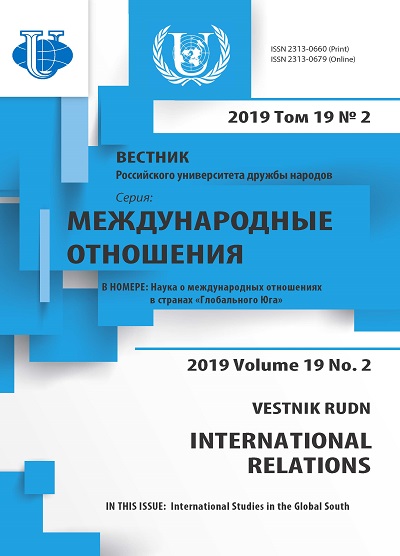Development of International Relations at the Periphery: The Case of Bangladesh
- Authors: Yasmin L.1
-
Affiliations:
- University of Dhaka
- Issue: Vol 19, No 2 (2019): International Studies in the Global South
- Pages: 247-255
- Section: THEMATIC DOSSIER
- URL: https://journals.rudn.ru/international-relations/article/view/21462
- DOI: https://doi.org/10.22363/2313-0660-2019-19-2-247-255
- ID: 21462
Cite item
Full Text
Abstract
International Relations (IR) is no longer considered as an academic discipline that analyzes the major powers or great powers’ activities only. From its Cold War content of emphasizing on traditional state-centric security, it has traversed a long way to expand its subject matter. Similarly, smaller nations and their imprints on international politics are also emerging as a significant area of inquiry in IR. This article seeks to contribute to this inquiry by discussing Bangladesh’s rising significance and how academic IR addresses this issue. It traces the history of IR in Bangladesh as well as its gradual expansion. It discusses the growth of IR as an academic discipline at the University of Dhaka, Bangladesh, that gradually led to the development of IR studies in other parts of the country. The article documents this growth, which is the first of its kind to trace the rise and development of IR in Bangladesh. It therefore fulfils the lacuna in understanding how and where the growth of IR took place in a non-western country. One might contend what is the relevance of studying IR in Bangladesh. The article argues that despite being physically small , academic IR has generated interest in Bangladesh due to the changing geostrategic significance of the country. The article outlines the rising geopolitical significance of Bangladesh where great powers are interested to come and be a part of Bangladesh’s development. It is in this context, the study of IR becomes more pertinent in Bangladesh.
About the authors
Lailufar Yasmin
University of Dhaka
Author for correspondence.
Email: lyasmin@du.ac.bd
Professor at the Department of International Relations
Dhaka, BangladeshReferences
- Abdur Rahman, A.K.M. & Kabir, M. (2018). Changing Global Dynamics: Bangladesh Foreign Policy. Dhaka: BIISS.
- Ahmed, I. (Eds.). (2008). Terrorism in the 21st Century: Bangladeshi Perspectives. Dhaka: The University Press Limited (UPL).
- Ali Ashraf, A.S.M. (Eds.). (2016). Intelligence, National Security, and Foreign Policy: A South Asian Narrative. Dhaka: Bangladesh Institute of Law and International Affairs / Department of International Relations, University of Dhaka.
- Asadullah, M.N., Savoia, A. & Mahmud, W. (2014). Paths to Development: Is there a Bangladesh Surprise? World Development, 62, 138-154. DOI: https://doi.org/10.1016/j.worlddev.2014.05.013.
- Brewster, D. (2014). Is India Losing Bay of Bengal to China? The Interpreter. The Lowy Institute. March 19. URL: http://www.lowyinterpreter.org/the-interpreter/india-losing-bay-bengal (accessed: 15.04. 2019).
- Buchanan, A. & Moore, M. (2003). Introduction: The Making and Unmaking of Boundaries. In: States, Nations, and Borders: the Ethics of Making Boundaries / Ed. by A. Buchanan, M. Moore. New York: Cambridge University Press.
- Choudhury, D. (1992). Bangladesh’s Foreign Policy Outlook: Regional and International Settings. In: Bangladesh, South Asia and the World / Ed. by E. Ahamed, A. Kalam. Dhaka: Academic Publishers.
- Fair, C.C. (2018). Bangladesh in 2018: Careening toward One-Woman Rule. Asian Survey, 59 (1), 124-132.
- Hassan, S. (1989). The India Factor in the Foreign Policy of Bangladesh. In: Issues and Challenges Facing Bangladesh Foreign Policy / Ed. by M.G. Kabir, S. Hassan. Dhaka: Bangladesh Society of International Studies.
- Huq, M.S. (1993). Bangladesh in International Politics: The Dilemmas of the Weak State. Dhaka: The University Press Limited.
- Husain, T. (1988). Domestic Inputs in Foreign Policy. In: Bangladesh: Global Politics. Vol. 3 / Ed. by S.R. Chakravaty, V. Narain. New Delhi: South Asian publishers.
- Imam, S.H. (2014). Grasping Our Strategic Potential and Tapping It. The Daily Star, April 25.
- Jahan, R. (1972). Bangladesh in 1972: Nation Building in a New State. Asian Survey, 13 (2), 199-210. doi: 10.2307/2642736.
- Mahmud, W., Ahmed, S. & Mahajan, S. (2008). Economic Reforms, Growth and Governance: the Political Economy Aspects of Bangladesh’s Development Surprise. World Bank on behalf of the Commission on Growth and Development Working Paper, 22. Washington DC.
- Miller, E.R. (2019). Indo-Pacific Strategy: Implications for the Region. In: Roundtable. BIPSS and The Daily Star.
- Mishra, V. (2018). China Is Moving into the Indian Ocean. The National Interest, April 14. URL: https://nationalinterest.org/ feature/china-moving-the-indian-ocean-25380 (accessed: 15.04.2019).
- Sabur, A.K.M.A. & Kabir, M.H. (2000). Conflict Management and Sub-regional Co-operation in ASEAN: Relevance of SAARC. Dhaka: BIISS.
- Sahoo, P. (2013). Economic Relations with Bangladesh: China’s Ascent and India’s Decline. South Asia Research, 33 (2), 123-139. DOI: https://doi.org/10.1177/0262728013487632.
- Sobhan, F. (Eds.). (2008). Countering Terrorism in Bangladesh. Dhaka: The University Press Limited.
- Yasmin, L. (2016). Bangladesh and the Great Powers. In: Handbook on Contemporary Bangladesh / Ed. by A. Riaz, Md. Sajjadur Rahman. London and New York: Routledge.
- Zaman, R.U. & Yasmin, L. (2014). The Rise of China and India: An Inevitable Confrontation at the Indian Ocean? In: Sino-South Asian Relations: Continuity and Change / Ed. by B. Md. Monoar Kabir. Chittagong: University of Chittagong.
- Zaman, R.U. (2016). UN Peacekeeping Mission. In: Handbook on Contemporary Bangladesh / Ed. by A. Riaz, Md. Sajjadur Rahman. London and New York: Routledge.
Supplementary files










